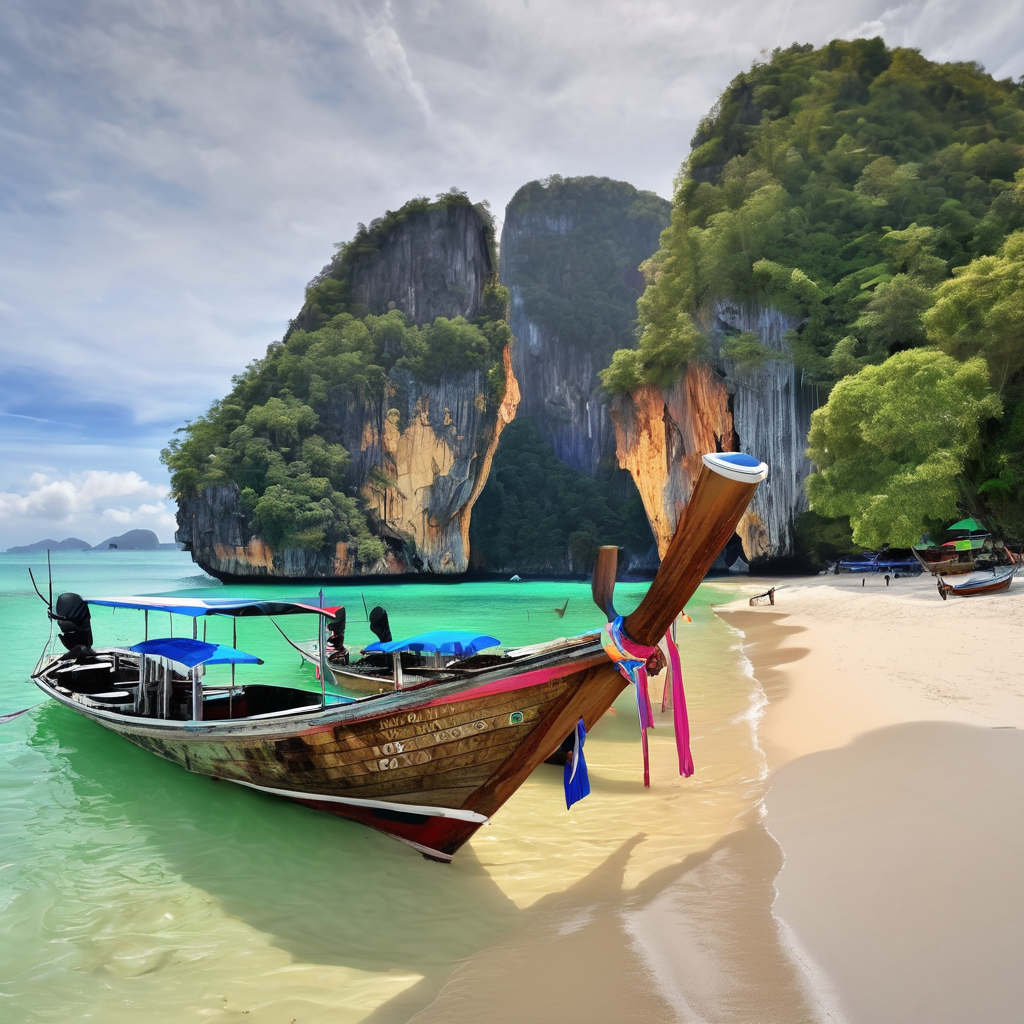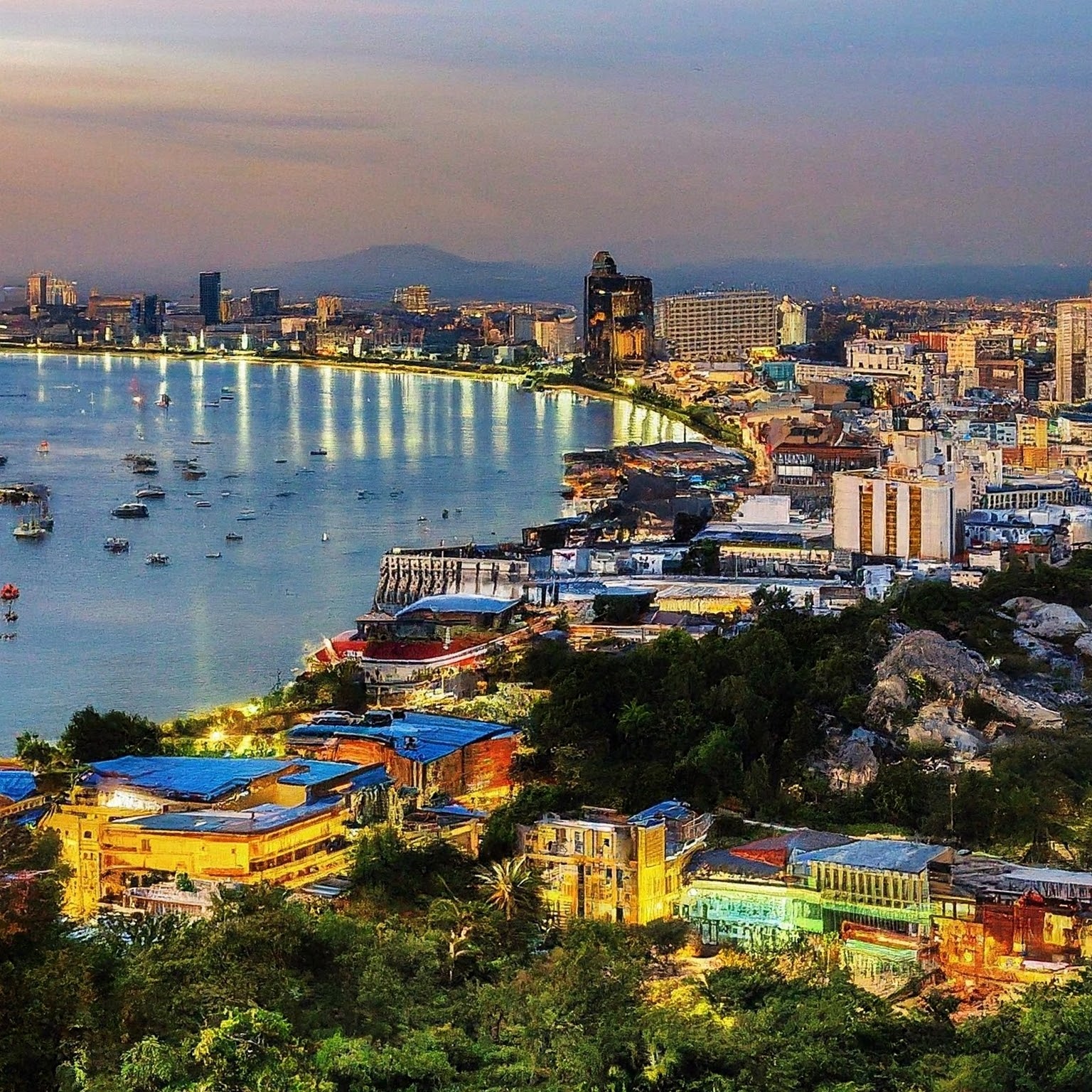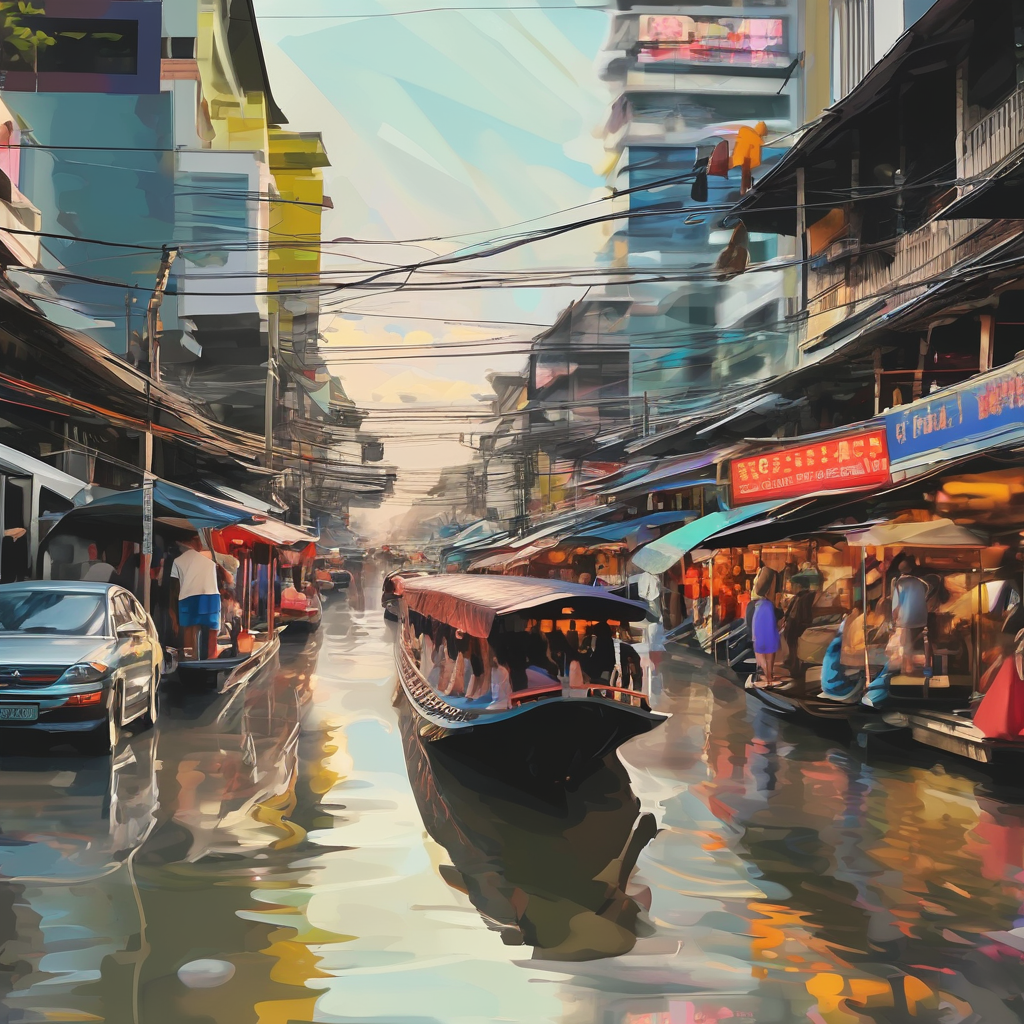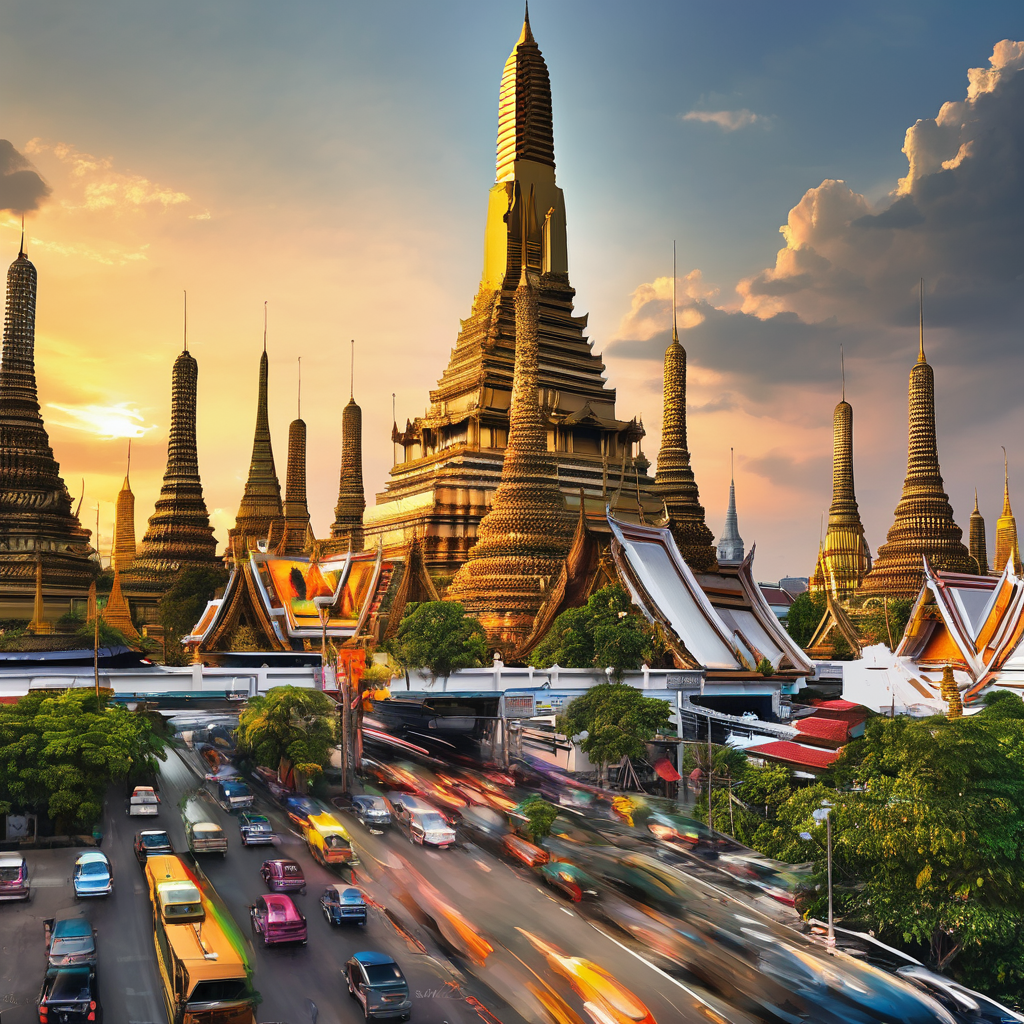“Experience the vibrant and diverse culture of Thailand by visiting its bustling markets, ancient temples, and sampling its world-renowned street food, like Pad Thai and Tom Yum soup”.
Explore the picturesque beaches of Phuket, indulge in the beauty of Chiang Mai’s lush mountains, and witness the rich history of Bangkok. Immerse yourself in the Land of Smiles’ warm and welcoming atmosphere throughout your journey.

Main Attraction
Thailand boasts a variety of travel attractions that captivate visitors from around the world. Here are some must-see destinations:
- Bangkok: The bustling capital city known for its vibrant street life, ornate temples like Wat Arun and Wat Phra Kaew, and the opulent Grand Palace.
- Phuket: Famous for its stunning beaches, crystal-clear waters, and vibrant nightlife, as well as its luxurious resorts and water activities.
- Chiang Mai: Nestled in the mountains of northern Thailand, this city is renowned for its beautiful temples, night markets, and rich cultural heritage.
- Ayutthaya: A UNESCO World Heritage Site, this ancient city is home to impressive temple ruins and historical sites, offering a glimpse into Thailand’s rich history.
- Krabi: Known for its dramatic limestone cliffs, clear waters, and idyllic beaches, Krabi is a paradise for beach lovers and adventurers alike.
- Pai: A laid-back town in the mountains known for its stunning landscapes, waterfalls, and relaxed atmosphere, making it a favorite among backpackers.
- Sukhothai: Another UNESCO World Heritage Site, this historical park contains the ruins of the ancient capital of the Sukhothai Kingdom, with well-preserved temples and monuments.
- Koh Samui: A tropical island with palm-fringed beaches, coconut groves, and luxury resorts, perfect for a relaxing getaway.
- Pattaya: Known for its beaches, nightlife, and entertainment options, including water sports and theme parks.
- Kanchanaburi: Home to the famous Bridge over the River Kwai, this area is rich in World War II history and features beautiful natural parks and waterfalls.
These attractions, combined with Thailand’s friendly people and delicious cuisine, make it a top destination for travelers.
Foods to Taste.
Thailand offers a rich culinary experience with a variety of flavorful dishes that are a must-try for any visitor. Here are some foods to taste in Thailand:

- Pad Thai: Stir-fried rice noodles with eggs, tofu, shrimp or chicken, bean sprouts, peanuts, and lime, often garnished with fresh herbs.
- Tom Yum Goong: A hot and sour soup made with shrimp, lemongrass, kaffir lime leaves, galangal, lime juice, fish sauce, and crushed chili peppers.
- Som Tum: Spicy green papaya salad mixed with tomatoes, green beans, peanuts, and chili, typically flavored with lime juice and fish sauce.
- Massaman Curry: A rich and mild curry with potatoes, peanuts, and meat (often beef or chicken), flavored with cinnamon, cardamom, and tamarind.
- Green Curry (Gaeng Keow Wan): A spicy green curry made with coconut milk, green curry paste, and a variety of meats and vegetables, often served with rice.
- Khao Pad: Thai-style fried rice with vegetables, egg, and your choice of meat, typically garnished with cucumber and lime.
- Pad Krapow: Stir-fried basil with minced meat (usually pork or chicken), garlic, chili, and served over rice, often topped with a fried egg.
- Moo Ping: Grilled marinated pork skewers, often served with sticky rice and a spicy dipping sauce.
- Larb: A spicy salad made with minced meat (usually chicken or pork), fresh herbs, lime juice, fish sauce, and ground roasted rice.
- Khao Soi: A northern Thai dish featuring egg noodles in a rich coconut curry broth, topped with crispy noodles, pickled mustard greens, shallots, and lime.
- Mango Sticky Rice (Khao Niew Mamuang): A popular dessert made with sweet sticky rice, ripe mango slices, and coconut milk.
- Satay: Skewered and grilled meat (often chicken or pork) served with a rich peanut sauce and cucumber relish.
- Tom Kha Gai: A creamy and aromatic soup made with chicken, coconut milk, galangal, lemongrass, and kaffir lime leaves, flavored with lime juice and fish sauce.
- Hor Mok: A steamed curry custard with fish and coconut milk, often served in banana leaves.
Sampling these dishes will give you a taste of Thailand’s diverse and delicious cuisine.
Best time to visit.
The best time to visit Thailand generally falls during the cool and dry season, which is from November to February. Here’s a breakdown of the seasons to help you decide:
- Cool Season (November to February): This is the most popular time to visit Thailand, with pleasant temperatures ranging from 20°C to 30°C (68°F to 86°F) and low humidity. It’s ideal for outdoor activities, sightseeing, and visiting the beaches. However, it’s also the peak tourist season, so popular destinations can be crowded, and prices for accommodations and flights may be higher.
- Hot Season (March to May): During this time, temperatures can soar above 35°C (95°F), especially in April. While it’s hot, it’s a great time for beach vacations and water activities. However, inland areas and cities like Bangkok can be uncomfortably hot.
- Rainy Season (June to October): This season is characterized by heavy and frequent rains, high humidity, and occasional flooding, particularly in September and October. While the rain can be intense, it usually comes in short bursts, and the countryside becomes lush and green. This is also a good time to find deals on accommodations and flights, and popular tourist spots are less crowded.
Overall, the cool season from November to February is the best time to experience Thailand’s attractions comfortably. However, the hot and rainy seasons also have their unique advantages depending on your interests and tolerance for heat and rain.

How to go ?
Traveling to Thailand is straightforward, with several options depending on your starting point and preferences. Here are the main ways to get to Thailand:
By Air:
International Flights:
- Bangkok (Suvarnabhumi Airport – BKK): The primary international gateway to Thailand, serving numerous airlines and direct flights from major cities worldwide.
- Bangkok (Don Mueang International Airport – DMK): Another option in Bangkok, primarily serving budget airlines and regional flights.
- Phuket International Airport (HKT): Ideal for those heading directly to the southern beaches and islands.
- Chiang Mai International Airport (CNX): Convenient for visitors traveling to northern Thailand.
Major Airlines:
- Thai Airways
- Qatar Airways
- Emirates
- Singapore Airlines
- Cathay Pacific
- Etihad Airways
- Budget airlines like AirAsia, Scoot, and Jetstar
By Land:
From Neighboring Countries:
- Malaysia: You can cross the border by train or bus from Kuala Lumpur or Penang to Hat Yai or other southern Thai cities.
- Laos: Crossings are possible by bus or car, with popular entry points at Vientiane to Nong Khai or Luang Prabang to Chiang Khong.
- Cambodia: Buses and taxis connect Siem Reap and Phnom Penh to Bangkok and other Thai cities.
- Myanmar: Border crossings are available, but check current visa and travel restrictions.
By Sea:
Cruises:
- Several cruise lines offer itineraries that include stops at Thai ports like Phuket, Bangkok (Laem Chabang), and Koh Samui.
Ferries:
- From nearby islands in Malaysia (Langkawi to Satun) and Indonesia, though these are less common.
Entry Requirements:
- Visa: Depending on your nationality, you may require a visa to enter Thailand. Many countries have visa exemption agreements with Thailand, allowing stays of 15-90 days. Check with the Thai consulate or embassy for specific requirements.
- Passport: Ensure your passport is valid for at least six months beyond your planned departure date.
- Health and Safety: Be aware of any vaccination requirements and stay updated on travel advisories.
Planning your trip well in advance, including booking flights and accommodations, can help ensure a smooth and enjoyable journey to Thailand.
Travel Tips:
Here are some essential travel tips for visiting Thailand:
- Respect Local Customs and Culture:
- Thailand has a rich cultural heritage, and it’s important to respect local customs, traditions, and etiquette. For example, dress modestly when visiting temples, remove your shoes before entering sacred places, and be mindful of public displays of affection.
- Stay Hydrated:
- Thailand can be hot and humid, especially during the hot season. Stay hydrated by drinking plenty of water, especially if you’re spending time outdoors or on the beach.
- Try Local Street Food:
- Thai street food is delicious and a big part of the culinary experience. Don’t miss out on trying dishes like Pad Thai, Tom Yum soup, and various curries from street vendors. Look for places that are busy with locals to ensure freshness and quality.
- Bargain in Markets:
- When shopping at markets and street stalls, bargaining is common practice. Approach it with a friendly attitude and be prepared to negotiate prices, especially at places like Chatuchak Weekend Market in Bangkok.
- Be Mindful of Scams:
- Like any tourist destination, Thailand has its share of scams. Be cautious of overly friendly strangers offering unsolicited advice or tours, and always use licensed taxis or ride-hailing services like Grab.
- Respect the Monarchy:
- The Thai monarchy is highly revered, and criticism of the royal family is illegal and can result in severe penalties. Avoid any discussion or behavior that could be seen as disrespectful.
- Stay Safe:
- Thailand is generally safe for travelers, but exercise normal precautions. Keep an eye on your belongings in crowded places, avoid walking alone late at night in unfamiliar areas, and be cautious of drink spiking in nightlife spots.
- Learn Basic Thai Phrases:
- Knowing a few basic Thai phrases like greetings (sawadee krub/ka), thank you (khob khun krub/ka), and numbers can go a long way in showing respect and making interactions smoother.
- Respect Wildlife:
- If visiting wildlife attractions, choose responsible operators that prioritize animal welfare. Avoid activities that involve direct interaction with wild animals or support unethical practices.
- Pack Light and Comfortable Clothing:
- Lightweight and breathable clothing is ideal, especially during the hot season. Pack comfortable walking shoes, a hat, sunglasses, and sunscreen for protection against the sun.
Following these tips will help you have a memorable and enjoyable trip to Thailand while respecting the local culture and ensuring your safety.

Travel Cost:
The cost of traveling in Thailand can vary widely depending on your travel style, preferences, and itinerary. Here’s a breakdown of typical expenses to help you plan your budget:
- Accommodation:
- Budget: $20 – $50 USD per night for basic guesthouses or hostels.
- Mid-Range: $50 – $100 USD per night for comfortable hotels or boutique accommodations.
- Luxury: $100 USD and above per night for luxury resorts and hotels, especially in tourist hotspots like Bangkok, Phuket, and Koh Samui.
- Food and Dining:
- Street Food: $1 – $3 USD per meal. Street stalls and local eateries offer delicious and affordable options.
- Local Restaurants: $5 – $10 USD per meal. Eating at mid-range restaurants or cafes.
- Upscale Restaurants: $15 USD and above per meal. Fine dining and international cuisine.
- Transportation:
- Public Transport: $0.50 – $2 USD for local buses or trains in cities like Bangkok.
- Taxis and Tuk-Tuks: Start around $1 – $2 USD, with fares increasing based on distance and negotiation.
- Domestic Flights: Varies, but budget airlines like AirAsia offer competitive rates for flights between major cities.
- Activities and Attractions:
- Temples and Cultural Sites: Many temples are free, but some may charge a small entrance fee (e.g., $1 – $3 USD).
- Tours and Excursions: Prices vary widely depending on the activity. For example, island-hopping tours can range from $20 – $50 USD.
- Entertainment: Shows and nightlife expenses can vary greatly. Prices for cultural shows or nightclub entries range from $5 – $20 USD or more.
- Miscellaneous:
- Visa Fees: Depending on your nationality, visa fees may apply. Visa on Arrival (VOA) costs around $35 – $40 USD.
- Travel Insurance: Costs vary, but it’s recommended to have travel insurance to cover unexpected medical expenses or trip cancellations.
Sample Daily Budget:
- Budget Traveler: $30 – $50 USD per day (including accommodation in hostels, street food, and public transport).
- Mid-Range Traveler: $50 – $100 USD per day (including mid-range hotels, local restaurants, occasional tours).
- Luxury Traveler: $100 USD and above per day (including luxury hotels, fine dining, private tours, and upscale activities).
Keep in mind that prices can fluctuate based on the season, location, and your bargaining skills, especially in markets and when dealing with transport. Planning ahead and researching prices for your specific destinations will help you budget effectively for your trip to Thailand.








